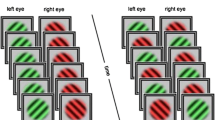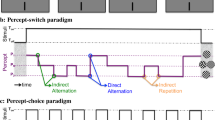Abstract
Rationale
During binocular rivalry, two incompatible images are presented to each eye and these monocular stimuli compete for perceptual dominance, with one pattern temporarily suppressed from awareness. One variant of stimulus presentation in binocular rivalry experiments is dichoptic stimulus alternation (DSA), when stimuli are applied to the eyes in rapid reversals. There is preliminary report that in contrast with healthy controls, schizophrenic patients can maintain binocular rivalry even at very high DSA rates.
Objective
The study was undertaken to investigate whether binocular rivalry survives high rates of DSA induced by the South American hallucinogenic beverage ayahuasca.
Methods
Ten individuals who were participating in ayahuasca ceremonials were requested to volunteer for binocular rivalry tests (DSA=0, 3.75, 7.5, 15 and 30 Hz) without and after drinking the brew.
Results
Ingestion of ayahuasca increased mean dominance periods both in standard binocular rivalry conditions (no DSA) and tests with DSA. At higher DSA rates (15 and 30 Hz) the total length of dominance periods was longer on the brew.
Conclusion
It is discussed that ayahuasca-induced survival of binocular rivalry at high DSA rates may be related to slow visual processing and increased mean dominance periods may result from hallucinogen-induced alteration of gamma oscillations in the visual pathways.



Similar content being viewed by others
References
Aghajanian GK, Marek GJ (1999) Serotonin and hallucinogens. Neuropsychopharmacology 21:16S–23S
Alais D, Blake R, Lee SH (1998) Visual features that vary together over time group together over space. Nat Neurosci 1:160–164
American Psychiatric Association (1994) Diagnostic and statistical manual of mental disorders, 4th edn. American Psychiatric Press, Washington
Ando K, Johanson CE, Levy DL, Yasillo NJ, Holzman PS, Schuster CR (1983) Effects of phencyclidine, secobarbital and diazepam on eye tracking in rhesus monkeys. Psychopharmacology 81:295–300
Andre JT, Tyrrell RA, Leibowitz HW, Nicholson ME, Wang M (1994) Measuring and predicting the effects of alcohol consumption on contrast sensitivity for stationary and moving gratings. Percept Psychophys 56:261–267
Blake R (1989) A neural theory of binocular rivalry. Psychol Rev 96:145–167
Blake R (2001) A primer on binocular rivalry, including current controversies. Brain Mind 2:5–38
Blake R, Logothetis NK (2002) Visual competition. Nat Rev Neurosci 3:13–21
Braff DL, Saccuzzo DP (1982) Effect of antipsychotic medication on speed of information processing in schizophrenic patients. Am J Psychiatry 139:1127–1130
Braff DL, Silverton L, Saccuzzo DP, Janowsky DS (1981) Impaired speed of visual information processing in marijuana intoxication. Am J Psychiatry 138:613–617
Braff DL, Saccuzzo DP, Geyer MA (1991) Information processing dysfunctions in schizophrenia: studies of visual backward masking, sensorimotor gating, and habituation. In: Steinhauer SR, Gruzelier JH, Zubin J (eds) Neuropsychology, psychophysiology, and information processing (Handbook of Schizophrenia, vol 5). Elsevier Science Publishers, Amsterdam, pp 303–334
Briggs GG, Nebes RD (1975) Patterns of hand preference in a student population. Cortex 11:230–238
Butler PD, Harkavy-Friedman JM, Amador XF, Gorman JM (1996) Backward masking in schizophrenia: relationship to medication status, neuropsychological functioning, and dopamine metabolism. Biol Psychiatry 40:295–298
Callaway JC, Raymon LP, Hearn WL, McKenna DJ, Grob CS, Brito GS, Mash DC (1996) Quantitation of N,N-dimethyltryptamine and harmala alkaloids in human plasma after oral dosing with ayahuasca. J Anal Toxicol 20:492–497
Callaway JC, McKenna DJ, Grob CS, Brito GS, Raymon LP, Poland RE, Andrade EN, Andrade EO, Mash DC (1999) Pharmacokinetics of hoasca alkaloids in healthy humans. J Ethnopharmacol 65:243–256
Cobo-Lewis AB, Gilroy LA, Smallwood TB (2000) Dichoptic plaids may rival, but their motions can integrate. Spat Vis 13:415–429
Dayan P (1998) A hierarchical model of binocular rivalry. Neural Comput 10:1119–1135
De Pascalis V, Ray WJ (1998) Effects of memory load on event-related patterns of 40-Hz EEG during cognitive and motor tasks. Int J Psychophysiol 28:301–315
Dobkin de Rios M (1972) Visionary vine: psychedelic healing in the Peruvian Amazon. Chandler Publishing, San Francisco
Doheny HC, Whittington MA (1998) Synchronous interhippocampal gamma oscillations are disrupted by the hallucinogen mescaline. J Physiol 513P:23P–24P
Farmer SF (1998) Rhythmicity, synchronization and binding in human and primate motor systems. J Physiol 509:3–14
Fox R (1991) Binocular rivalry. In: Regan D (ed) Binocular vision. Macmillan, London
Frecska E, White KD, Leonard CM, Kuldau JM, Bengtson M, Ricciuti N, Luna L, Mahoney B, Pettigrew J (2003) Binocular rivalry in schizophrenia and drug-induced psychosis. Neuropsychopharmacologia Hungarica 5:4–13
Fries P, Schroder JH, Roelfsema PR, Singer W, Engel AK (2002) Oscillatory neuronal synchronization in primary visual cortex as a correlate of stimulus selection. J Neurosci 22:3739–3754
Geyer MA (1998) Behavioral studies of hallucinogenic drugs in animals: implications for schizophrenia research. Pharmacopsychiatry 31:73–79
Gouzoulis-Mayfrank E, Heekeren K, Thelen B, Lindenblatt H, Kovar KA, Sass H, Geyer MA (1998) Effects of the hallucinogen psilocybin on habituation and prepulse inhibition of the startle reflex in humans. Behav Pharmacol 9:561–566
Gouzoulis-Mayfrank E, Thelen B, Maier S, Heekeren K, Kovar KA, Sass H, Spitzer M (2002) Effects of the hallucinogen psilocybin on covert orienting of visual attention in humans. Neuropsychobiology 45:205–212
Green MF, Nuechterlein KH, Breitmeyer B, Mintz J (1999) Backward masking in unmedicated schizophrenic patients in psychotic remission: possible reflection of aberrant cortical oscillation. Am J Psychiatry 156:1367–1373
Green MF, Mintz J, Salveson D, Nuechterlein KH, Breitmeyer B, Light GA, Braff DL (2003) Visual masking as a probe for abnormal gamma range activity in schizophrenia. Biol Psychiatry (in press)
Hampson RE, Foster TC, Deadwyler SA (1989) Effects of delta-9-tetrahydrocannabinol on sensory evoked hippocampal activity in the rat: Principal components analysis and sequential dependency. J Pharmacol Exp Ther 251:870–877
Javitt DC, Lindsley RW (2001) Effects of phencyclidine on prepulse inhibition of acoustic startle response in the macaque. Psychopharmacology 156:165–168
Javitt DC, Jayachandra M, Lindsley RW, Specht CM, Schroeder CE (2000) Schizophrenia-like deficits in auditory P1 and N1 refractoriness induced by the psychomimetic agent phencyclidine (PCP). Clin Neurophysiol 111:833–836
Jin J, Yamamoto T, Watanabe S (1997) The involvement of sigma receptors in the choice reaction performance deficits induced by phencyclidine. Eur J Pharmacol 319:147–152
Jones CK, Shannon HE (2000) Effects of scopolamine in comparison with apomorphine and phencyclidine on prepulse inhibition in rats. Eur J Pharmacol 391:105–112
Lee KH, Williams LM, Breakspear M, Gordon E (2003) Synchronous gamma activity: a review and contribution to an integrative neuroscience model of schizophrenia. Brain Res Brain Res Rev 41:57–78
Levelt WJM (1965) On binocular rivalry. Royal Van Gorcum, Assen
Leweke FM, Schneider U, Thies M, Munte TF, Emrich HM (1999) Effects of synthetic delta9-tetrahydrocannabinol on binocular depth inversion of natural and artificial objects in man. Psychopharmacology 142:230–235
Light GA, Braff DL (1999) Human and animal studies of schizophrenia-related gating deficits. Curr Psychiatr Rep 1:31–40
Linn GS, Javitt DC (2001) Phencyclidine (PCP)-induced deficits of prepulse inhibition in monkeys. Neuroreport 12:117–120
Logothetis NK, Leopold DA, Sheinberg DL (1996) What is rivalling during binocular rivalry? Nature 380:621–624
Luna LE (1984) The healing practices of a Peruvian shaman. J Ethnopharmacol 11:123–133
Luna LE (1986) Vegetalismo. Shamanism among the Mestizo population of the Peruvian Amazon. Almqvist & Wiksell International, Stockholm
McClure RK (2001) The visual backward masking deficit in schizophrenia. Prog Neuropsychopharmacol Biol Psychiatry 25:301–311
Meltzer HY, McGurk SR (1999) The effects of clozapine, risperidone, and olanzapine on cognitive function in schizophrenia. Schizophr Bull 25:233–255
Miller SM, Liu GB, Ngo TT, Hooper G, Riek S, Carson RG, Pettigrew JD (2000) Interhemispheric switching mediates perceptual rivalry. Curr Biol 10:383–392
National Commission for the Protection of Human Subjects of Biomedical and Behavioral Research (1979) Ethical principles and guidelines for the protection of human subjects of research. The Belmont Report. US Government Printing Office, Washington
Ouagazzal A, Grottick AJ, Moreau J, Higgins GA (2001) Effect of LSD on prepulse inhibition and spontaneous behavior in the rat. A pharmacological analysis and comparison between two rat strains. Neuropsychopharmacology 25:565–575
Pantev C, Elbert T, Makeig S, Hampson S, Eulitz C, Hoke M (1993) Relationship of transient and steady-state auditory evoked fields. Electroencephalogr Clin Neurophysiol 88:389–396
Pettigrew JD (2001) Searching for the switch: neural bases for perceptual rivalry alternations. Brain Mind 2:85–118
Pettigrew JD, Miller SM (1998) A “sticky” interhemispheric switch in bipolar disorder? Proc R Soc Lond B Biol Sci 265:2141–2148
Ploner CJ, Tschirch A, Ostendorf F, Dick S, Gaymard BM, Rivaud-Pechoux S, Sporkert F, Pragst F, Stadelmann AM (2002) Oculomotor effects of delta-9-tetrahydrocannabinol in humans: implications for the functional neuroanatomy of the brain cannabinoid system. Cereb Cortex 12:1016–1023
Polonsky A, Blake R, Braun J, Heeger DJ (2000) Neuronal activity in human primary visual cortex correlates with perception during binocular rivalry. Nat Neurosci 3:1153–1159
Purdon SE, Jones BD, Stip E, Labelle A, Addington D, David SR, Breier A, Tollefson GD (2000) Neuropsychological change in early phase schizophrenia during 12 months of treatment with olanzapine, risperidone, or haloperidol. The Canadian Collaborative Group for research in schizophrenia. Arch Gen Psychiatry 57:249–258
Purushothaman G, Ogmen H, Bedell HE (2000) Gamma-range oscillations in backward-masking functions and their putative neural correlates. Psychol Rev 107:556–577
Riba J, Rodriguez-Fornells A, Urbano G, Morte A, Antonijoan R, Montero M, Callaway JC, Barbanoj MJ (2001) Subjective effects and tolerability of the South American psychoactive beverage Ayahuasca in healthy volunteers. Psychopharmacology 154:85–95
Riba J, Rodriguez-Fornells A, Barbanoj MJ (2002) Effects of ayahuasca on sensory and sensorimotor gating in humans as measured by P50 suppression and prepulse inhibition of the startle reflex, respectively. Psychopharmacology 165:18–28
Riba J, Valle M, Urbano G, Yritia M, Morte A, Barbanoj MJ (2003) Human pharmacology of Ayahuasca: subjective and cardiovascular effects, monoamine metabolite excretion, and pharmacokinetics. J Pharmacol Exp Ther 306:73–83
Rund BR (1993) Backward-masking performance in chronic and nonchronic schizophrenics, affectively disturbed patients, and normal control subjects. J Abnorm Psychol 102:74–81
Saccuzzo DP, Braff DL (1986) Information-processing abnormalities: trait- and state-dependent components. Schizophr Bull 12:447–459
Schultes RE (1982) The beta-carboline hallucinogens of South America. J Psychoact Drugs 14:205–220
Shanon B (2002) The Antipodes of the mind: charting the phenomenology of the Ayahuasca experience. Oxford University Press, Oxford
Sheinberg DL, Logothetis NK (1997) The role of temporal cortical areas in perceptual organization. Proc Natl Acad Sci USA 94:3408–3413
Singer W (1993) Synchronization of cortical activity and its putative role in information processing and learning. Annu Rev Physiol 55:349–374
Sipes TE, Geyer MA (1997) DOI disrupts prepulse inhibition of startle in rats via 5-HT2A receptors in the ventral pallidum. Brain Res 761:97–104
Strassman RJ (1996) Human psychopharmacology of N,N-dimethyltryptamine. Behav Brain Res 73:121–124
Szara S (1956) Dimethyltryptamine: its metabolism in man; the relation of its psychotic effect to the serotonin metabolism. Experientia 12:441–442
Tong F (2003) Primary visual cortex and visual awareness. Nat Rev Neurosci 4:219–229
Umbricht D, Javitt D, Novak G, Bates J, Pollack S, Lieberman J, Kane J (1999) Effects of risperidone on auditory event-related potentials in schizophrenia. Int J Neuropsychopharmacol 2:299–304
Vollenweider FX, Vollenweider-Scherpenhuyzen MF, Babler A, Vogel H, Hell D (1998) Psilocybin induces schizophrenia-like psychosis in humans via a serotonin-2 agonist action. Neuroreport 9:3897–3902
Vollenweider FX, Remensberger S, Hell D, Geyer MA (1999) Opposite effects of 3,4-methylenedioxymethamphetamine (MDMA) on sensorimotor gating in rats versus healthy humans. Psychopharmacology 143:365–372
Weiner RU, Opler LA, Kay SR, Merriam AE, Papouchis N (1990) Visual information processing in positive, mixed, and negative schizophrenic syndromes. J Nerv Ment Dis 178:616–626
Wright P, Nolan NJ, Mahoney BP, White KD, Kuldau JM, Leonard CM (2003) Binocular rivalry is slower in first-degree relatives in schizophrenics. International Congress on Schizophrenia Research, Colorado Springs (poster presentation)
Acknowledgments
The authors thank Eva Wiesenmayer, Richard Bonenfant and Sherman Wissinger for their help in preparation of the manuscript.
Author information
Authors and Affiliations
Corresponding author
Rights and permissions
About this article
Cite this article
Frecska, E., White, K.D. & Luna, L.E. Effects of ayahuasca on binocular rivalry with dichoptic stimulus alternation. Psychopharmacology 173, 79–87 (2004). https://doi.org/10.1007/s00213-003-1701-x
Received:
Accepted:
Published:
Issue Date:
DOI: https://doi.org/10.1007/s00213-003-1701-x




